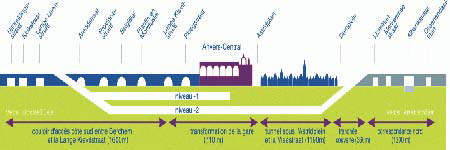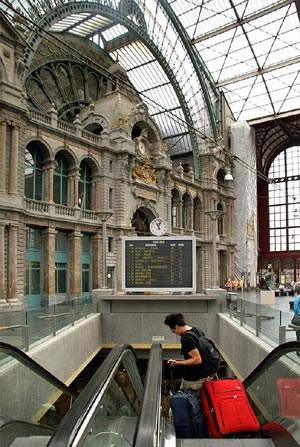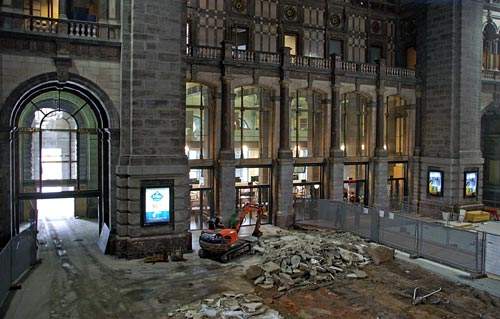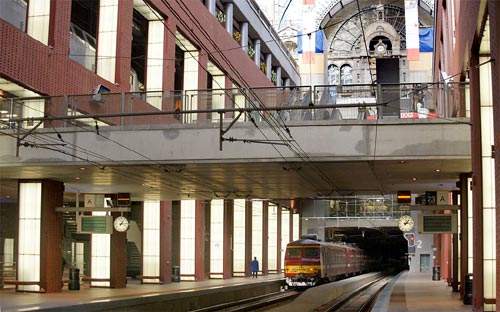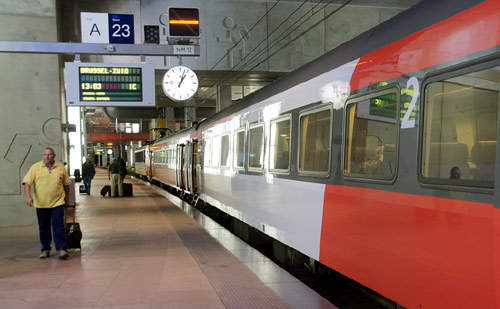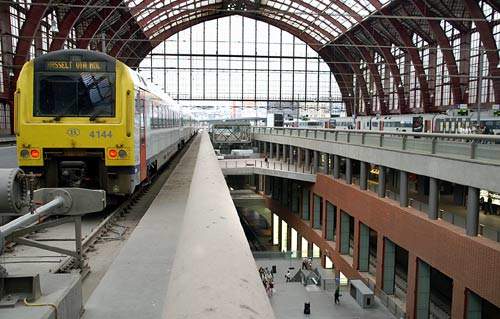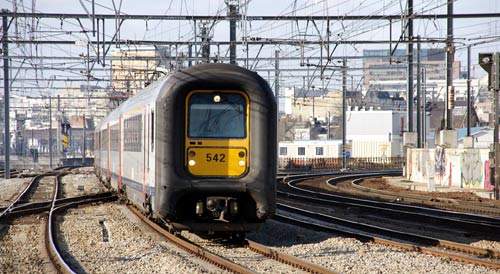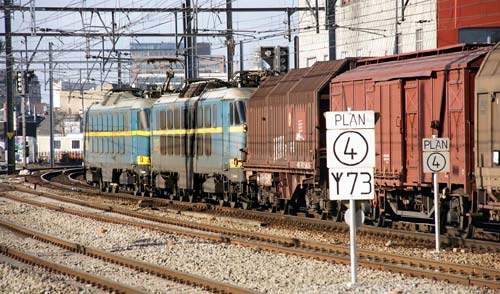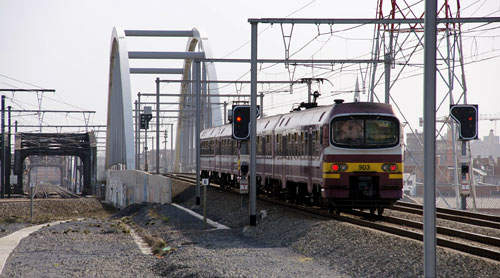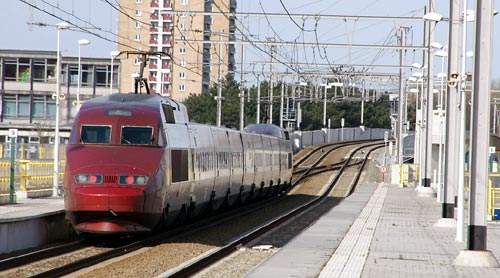With similarities to the Berlin Hauptbahnhof and north-south tunnel developments opened in 2006, the Belgian city of Antwerp (Dutch: Antwerpen; French: Anvers) has substantially revised its railway operations by means of a major infrastructure project.
Many routes converge there, and Antwerp is an established rail focal point for both passenger and freight, as a traffic generator and an important interchange. Belgium’s second-largest city (pop. 460,000) is also one of Europe’s busiest ports.
THE PROJECT
Replacing an earlier structure in 1905, the principal Antwerp station, Antwerpen-Centraal, was built as a terminus east of the city’s historic centre in what became the ‘new town’ area.
Effectively on the end of an elevated siding from the Amsterdam-Brussels line at the inner suburb of Berchem, Centraal remained a limiting factor for service improvements due to through enforced reversal there and having to retrace movements back to Berchem.
Solving the operational problems at Antwerp has been one of the biggest recent railway undertakings in Belgium. Construction on the project began in 1998, pre-dating the organisational restructuring that came into force in January 2005. This created the state-owned SNCB Holding and its principal constituents, train operator SNCB (Société Nationale des Chemins de fer Belges)/NMBS (Nationale Maatschappij der Belgische Spoorwegen) and infrastructure organisation Infrabel.
INFRASTRUCTURE
Ending Centraal’s terminus status is the new 3.8km (2.36 mile) North-South Junction line. It runs between Luchtbal and Berchem stations, the tunnel twin-track section for 2.5km (1.55mile), widening to four tracks for the four platform faces on the new Level -2 at Centraal. Around 40% of the Infrabel total project cost of €765m related to the station works.
From Berchem, another set of four tracks terminates at Level -1, also new. The original high-level platforms (now designated Level +1) were lengthened from 375 to 425m and reduced in number from ten to six. With a net gain of four platforms, being able to accommodate longer trains, the ability for north-south services to run without reversal and reduced pathing conflicts, capacity at Centraal has been drastically increased.
The Junction line and low-level platforms officially opened in March 2007, with interim arrangements for platform use pending completion of the Level -1 terminus platforms. This happened by December 2007 and Brussels-Amsterdam Thalys services began to use the Level-2 platforms. Level 0 provides shops, including those representing Antwerp’s famed diamond trade. The final parts of the project will bring a new southern entrance into use and provide more access to the platforms.
The Centraal project had to preserve what is widely regarded as an architectural treasure, yet at the same time drastically increase capacity and modernise passenger facilities. Previously endangered by workings for the underground pre-metro lines (stations: Diamant and Astrid) that branch beneath the station area, the supports for Centraal have been much strengthened by works included in the project.
To avoid reliance upon artificial light and forced ventilation at the lower levels, a 26m-deep atrium has been created from Level +1 to Level -2, also benefiting the shops and offices at ground and mezzanine levels. All tracks are fitted with the Belgian standard electrification of 3,000V dc overhead supply.
There is a high level of freight movements in the area, much related to the docks which feature an extensive rail network. This will continue to use the surface-running avoiding line which loops around the east of the city centre. Regional, national and international passenger trains will use the tunnel or terminus platforms at Centraal.
Beyond the northern tunnel portal at Damplein, a bridge carries mainline tracks over others, giving access to the docks system and at high level over the Albert Canal. This new alignment is maintained through Antwerpen-Luchtbal station, where just to the north it links with the Belgian section of the new 35km (21.8 mile), 300km/h high-speed line to the Dutch border.
There is also connection to the ‘classic’ Amsterdam route via Roosendaal, still used by Benelux services pending opening of the high-speed lines.
ROLLING STOCK
Although no new stock specifically relates to the project, it has restored Amsterdam-Brussels ‘Benelux’ trains to Centraal. Serving Antwerp only at Berchem during reconstruction, these are now routed through the tunnel with stops at Centraal and Berchem. The stock is due to be drafted-in Bombardier ‘Traxx’ locomotives as reliability levels have reduced availability of the 1,500/3,000V dc SNCB/NMBS Class 11 that were created specifically for this service.
The Benelux stock will now remain in service until at least 2009 due to delays both to delivery of the Ansaldobreda V250 HiSpeed-operated 250km/h units and commissioning of the Dutch HSL Zuid section of the Brussels-Amsterdam line. Due for refurbishment in connection for the new lines, TGV-based Thalys stock now also provide a limited-stop Brussels-Amsterdam service via Centraal.
Centraal hosts many types of SNCB/NMBS rolling stock, which in spite of withdrawals remains a diverse fleet. In common with much of Europe, new multiple-unit deliveries have led to a reduction of locomotive-hauled trains. Push-pull or top-and-tail passenger operations have largely eradicated locomotive changes and light engine movements.
SIGNALLING / COMMUNICATIONS
The through tracks are dual fitted with Belgian TBL signalling and European Train Control System (ETCS). However, the fitting of appropriate ETCS to rolling stock such as the Thalys and the projected interim TRAXX/DB-type Class 186-hauled Amsterdam-Brussels trains has been a continuing source of delay to these operations.
The system’s control centre operates a dynamic evacuation guidance system whereby the evacuation of people is handled according to monitoring the specifics of a given situation, as opposed to a fixed plan.
Tunnels are fitted with detectors, cameras, heat and smoke discharge installations, emergency exits and sprinklers. There are two cross-connections in the drilled tunnel sections and three emergency exits. At Centraal, as well as in the main circulating areas, all platforms will be equipped with emergency equipment.
THE FUTURE
Although the ambitious Antwerp Centraal and connecting lines project is largely complete, as an integral part of an Amsterdam-Brussels high-speed line, it still awaits the showcase services intended to use it. Availability of the dedicated V250 stock and the line itself remain problematic, with late 2008 now seeming to be the most optimistic time for these changes to occur.

